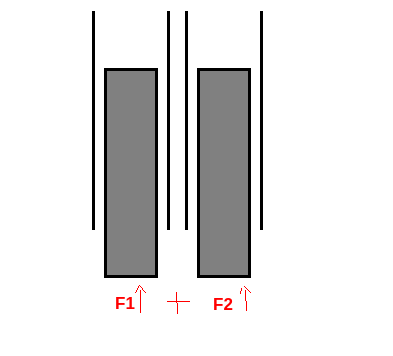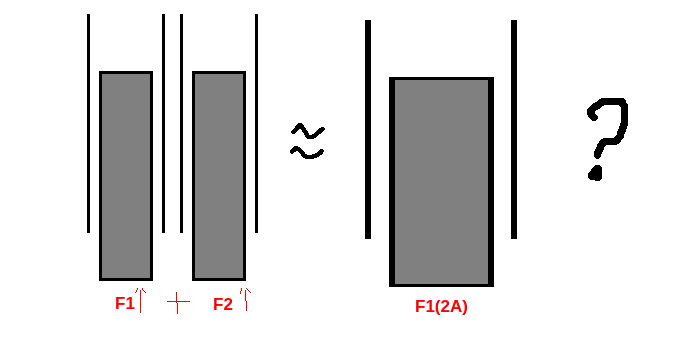The idea
If you have one solenoid that produces a single force. You can of course double this force by having two of the same sized solenoids next to each other pulling up on the same object.

This of course will use up 2 times the amount of current though. What happens if we double the amount of solenoids, but shrink the cross sectional area to have a diameter 1/2 the original size?

This may seem like an obvious answer for some, but I wanted to make sure my assumptions were correct, just in case.
To test this I added this code to the code from my previous log:
# Note that these parameters are mostly arbitrary,
# since the state of the solenoid doesn't really
# matter. All that matters is the difference in
# the measured forces
# between different
# This will be the applied current
current = getHoldingCurrent(opposingForce)
voltage = current*resistance
# The time change were giving the force function
t = .001
# The quantity of solenoids
quantity = 1
# The distance that the core is inserted into
# the solenoid for this test.
l = length/2
r = resistance
# Stores the previous force so we can find the
# difference between it and the new force.
last = 1
sum = 0 # Used to find average change in force
n = 30 # Number of tests
f = 0
for i in range(n):
I = current/quantity
f = quantity*force(I, t, l, 0)
print(f)
sum += f/last
last = f
coreRadius/=2
crossSectionalArea = m.pi*(coreRadius**2)
quantity*=2
resistance = r/quantity
I = voltage/r
print("Average change in force when replacing a solenoid with 2 solenoids with half the diameter F1 = F0*", sum/n)
Results:
5.889953125000001e-07
7.362441406250001e-08
9.203051757812501e-09
1.1503814697265627e-09
1.4379768371582033e-10
1.7974710464477542e-11
2.2468388080596927e-12
...
9.977968709316854e-28
1.2472460886646068e-28
1.5590576108307585e-29
1.948822013538448e-30
2.43602751692306e-31
3.045034396153825e-32
3.8062929951922815e-33
Average change in force when replacing a solenoid with 2 solenoids with half the diameter F1 = F0* 0.12083335296651042
Conclusions:
As you can see, the force decreases significantly when we replace a single solenoid with two having half the diameter. This is because the cross-sectional area is a dominating factor in the force since it is used in the calculation of both the inductance and the force. Another reason the force goes down is because we are actually decreasing the cross sectional area, because two circles with with diameters equal to the original radius, will have a smaller area than the original circle. One way we might improve is by instead of doing half the diameter, we use diameter / sqrt(2) which gives an equal cross sectional area. This is still defeated by the resistance that goes down each time we double the solenoid count, and therefore require a larger current. If we keep the current the same, then each individual solenoid will receive less and less. Basically It is a bad Idea to use many small solenoids, and the bigger the cross sectional area, the better.
 josh collins
josh collins
Discussions
Become a Hackaday.io Member
Create an account to leave a comment. Already have an account? Log In.